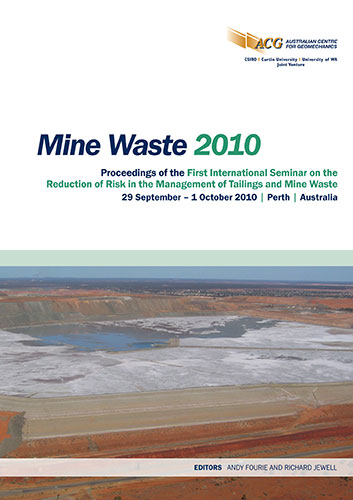Selection of parameters for semi-arid tailings storage facility design

|
Authors: Mundle, CAG; Chapman, PJ Paper is not available for download Contact Us |
DOI https://doi.org/10.36487/ACG_rep/1008_31_Mundle
Cite As:
Mundle, CAG & Chapman, PJ 2010, 'Selection of parameters for semi-arid tailings storage facility design', in R Jewell & AB Fourie (eds), Mine Waste 2010: Proceedings of the First International Seminar on the Reduction of Risk in the Management of Tailings and Mine Waste, Australian Centre for Geomechanics, Perth, pp. 361-374, https://doi.org/10.36487/ACG_rep/1008_31_Mundle
Abstract:
During the initial stage of tailings storage facility design, the selection of appropriate design parameters is paramount. In Western Australia, three key parameters that are typically unknown at the design stage and directly influence the design, and hence cost, of the tailings storage facility are: the beach slope that is likely to form in the field, the rate of rise at which the tailings can be placed, and the dry density that the tailings solids will achieve. This paper addresses two of these parameters, using the results of specialist test work that can be carried out at bench scale with approximately 50 kg of tailings solids to predict design parameters in the absence of site-specific field data. A summary of two cases studies is presented in which specialist tailings test work is used to predict the dry density during a typical tailings cycle, including deposition, settling, air-drying (evaporative desiccation) and consolidation. The two case studies represent tailings that display markedly different behaviour, which significantly impacts the costs associated with tailings management. This paper also presents the outcomes of a spreadsheet model, in which the data collected during the laboratory testing stage is used to more accurately predict the maximum rate of rise at which the tailings can be placed. This parameter is of significance as the rate of rise is typically limited to the rate at which sufficient evaporative desiccation occurs to allow wall raise construction to be carried out in the upstream direction, using tailings borrowed from the beach. A summary of the tests carried out and a convenient way of summarising the results are also presented.
References:
Australian Standard (AS) (1998) Determination of the one-dimensional consolidation properties of a soil,
AS 1289.6.6.1-1998.
Das, B.M. (2006) Principles of Geotechnical Engineering, 6th Edition, Thomas Canada Limited, 303 p.
Morris, P.H. and Williams, D.J. (1999) World Wide Correlations for Subaerial Aqueous Flows with Exponential
Longitudinal Profiles, Earth Surface Processes and Landforms, Vol. 24, pp. 867–879.
Vick, S.G. (1990) Planning, Design, and Analysis of Tailings Dams, John Wiley & Sons, pp. 42–44, 45–47, 71–74,
196–198.
© Copyright 2026, Australian Centre for Geomechanics (ACG), The University of Western Australia. All rights reserved.
View copyright/legal information
Please direct any queries or error reports to repository-acg@uwa.edu.au
View copyright/legal information
Please direct any queries or error reports to repository-acg@uwa.edu.au